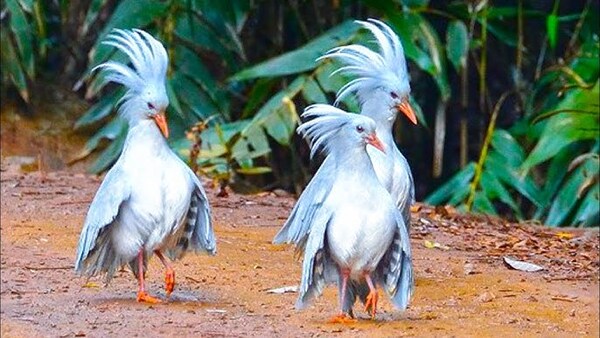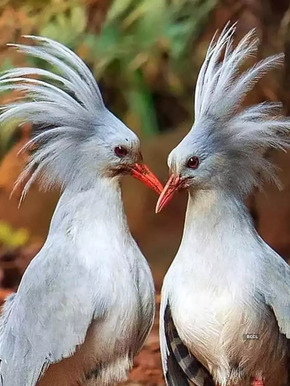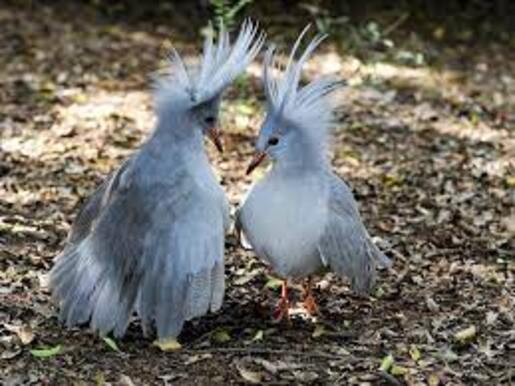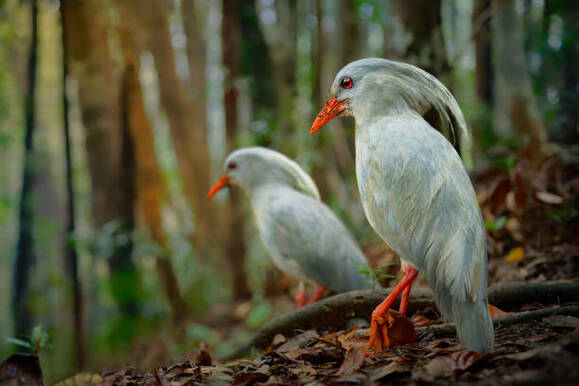Rhynochetus jubatus, commonly known as the Kagu, is a fascinating bird native to New Caledonia, an island group in the southwest Pacific. This unique species is known for its striking appearance, distinctive behaviors, and conservation status. In this article, we’ll explore the Kagu’s characteristics, habitat, diet, conservation status, and the efforts being made to protect it.

The Kagu is a medium-sized bird, measuring about 15 to 20 inches (38 to 50 cm) in length. It has a unique gray plumage with a soft, feathery texture, which helps it blend into its forest surroundings. One of its most notable features is its crest of feathers on top of its head, which can be raised or lowered depending on its mood. The Kagu also has bright orange-red legs and feet, adding a pop of color to its otherwise muted appearance.
Kagus are flightless birds, which is one of the reasons they have evolved such unique characteristics. They have strong legs that allow them to move quickly through their forest habitat. Their wings are small and not suited for flying, but they use them for balance while navigating the forest floor.

The Kagu is primarily found in the humid rainforests of New Caledonia. They prefer areas with dense underbrush, which provides shelter from predators and a rich source of food. Their habitat is essential for their survival, as it offers the necessary conditions for foraging and nesting.
Kagus are endemic to New Caledonia, meaning they are not found anywhere else in the world. Their limited range makes them particularly vulnerable to habitat loss due to deforestation and human activities.

The Kagu is an omnivorous bird, feeding on a variety of insects, small invertebrates, and plant material. They use their long, slender bills to probe the ground and leaf litter in search of food. This foraging behavior is essential for their diet, as it allows them to access food sources hidden in the forest floor.
The Kagu's diet plays a crucial role in maintaining the ecological balance of its habitat. By consuming insects and other invertebrates, they help control populations that could otherwise become pests. Additionally, their foraging activities help aerate the soil, promoting healthy plant growth.
Despite its unique adaptations, the Kagu faces several threats that have led to a decline in its population. Habitat destruction due to logging and agriculture poses the most significant risk. Additionally, introduced predators, such as rats and cats, have had a detrimental impact on Kagu populations by preying on their eggs and young birds.
The Kagu is classified as Endangered by the International Union for Conservation of Nature (IUCN). The global population is estimated to be around 1,000 to 2,500 individuals, with some estimates suggesting numbers as low as 800 breeding pairs. This limited population, combined with ongoing habitat loss and predation pressures, underscores the urgency of conservation efforts.
Efforts are underway to protect the Kagu and its habitat. Conservation organizations are working to preserve the remaining forest areas and educate the local population about the importance of protecting this unique species. Breeding programs in captivity are also being established to help boost the Kagu population. In addition, projects aimed at eradicating invasive species are crucial to protecting the Kagu's nests and young birds.

Rhynochetus jubatus, or the Kagu, is a remarkable bird that showcases the beauty and diversity of New Caledonia's wildlife. Its unique characteristics, behaviors, and dietary habits make it a vital part of its ecosystem. However, the challenges it faces highlight the importance of conservation efforts to ensure its survival. By raising awareness and taking action, we can help protect the Kagu for future generations to appreciate and enjoy. If you’re interested in learning more about this extraordinary bird, consider supporting conservation initiatives focused on preserving its habitat and safeguarding its future.
animal tags: Kagu Rhynochetus-jubatus
We created this article in conjunction with AI technology, then made sure it was fact-checked and edited by a Animals Top editor.